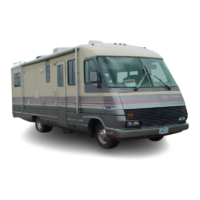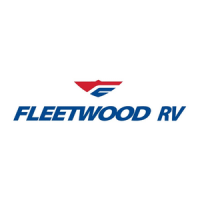off
the vehicle. The
"on
the
vehicle"
type, however,
is the more desirable in
that
all rolling components
lrotating brake components, bearings, seals, etc.)
are
included in the balancing process. Because
of
the
specialized equipment required, wheel and tire
balan-
cing should be performed
by
a qualified service shop.
Tire
Replacement
When replacing tires, be sure
to
consult
your
chassis
operator's
manual
for
Information regarding
the
proper tire selection. Use
of
the
incorrect
size or
type
tire may affect load carrying capacity. ride, handl-
ing, speedometer/odometer calibration. vehicle ground
clearance, and tire clearance
to
the
body
and chassis.
If
replacing
only
a single tire,
it
should be paired on
the
same axle
with
the
least
worn
tire
of
the
others.
WARNING:
DO NOT
MIX
DIFFERENT TYPES
OF
TIRES
ON
THE SAME VEHICLE.SUCH
AS
RA-
DIAL. BIAS,
AND
BIAS-BELTED TIRES EXCEPT
IN EMERGENCIES, BECAUSE VEHICLE HANDL-
ING
AND
TIRE LIFE
MAY
BE
SERIOUSLY AF-
FECTED
AND
MAY
RESULT IN LOSS OF CON-
TROL
OR
TIRE FAILURE.
ENGINE (Refer
to
Chassis
Operator's
Manual)
Your
motor
home is equipped
with
either a
454
CID
(Chevrolet chassis)
or
460
CID(Ford
or .Oshkosh
chassis) gasoline engine. Refer
to
the
chassis
operator's manual
for
specific fuel recommendations.
Engine Oils
Refer
to
the
chassis operator's mantlal and vehicle
maintenance
schedule
for
the
oil type,
viscosity
and
change intervals recommended
for
the
operating con-
ditions
encountered.
ENGINE FUEL SYSTEMS
Fuel
and
Air
Filters
Inspect
and replace fuel and air filters acc;.ording
to
the
chassis manufacturer's Maintenance Schedule.
Inspect
and
maintain
the
fuel and emission con-
trol systems in accordance
with
the cihassis' manufac-
turer's
Maintenance
Schedule. Check fuel lines for
signs
of
leakage, damage or
deterioration.nghten
-
clamps
if
they
are loose. Replace filters
In
the
fuel
line
and
the
evaporative
control
system
at
the
recom-
mended
intervals. .
Air
Cleaner
Element
Replacement
Replace
the
air
cleaner element according to the
chassis
manufacturer's
maintenance schedule.
COOLING SYSTEM
Maintenance
and
Inspection
Check
the
coolant
level, appearance, and strength
periodically. Drain and replace
at
the intervals recom-
40
mended in the Maintenance Schedule, or
SOOr.ler
if
it
is
dirty. Check
hos~s
regularly for signs of
damage
or deterioration,
and
tighten hose clamps if necessary.
Check hoses
for
cuts
or
abrasion damage.
If
the
hoses have become hard and
brittle
and
show
signs
of
cracking
as
a result
of
engine heat, replace
them.
Replace hoses
if
they are
soft
and spongy,
or
swollen
as
a result
of
exposure
to
oil and grease.
Any
flaking
or deterioration
of
the inner Iiniflg
of
the
hose
is
also
a reason for replacement.
Such particles can clog
the
cooling system, reducing Its efficiency.
Wash
the
radiator cap
with
clean
water
and
presstire'checkevery
12 months,
Coolant Level
The coolant level can be seen
in
the
"see
through"
recovery bottle while the engine Is
at
normal operating
temperature. The radiator
CI)P
need
not
normally
be
removed,
The
coolant level should be
at
the
"Full
Cold"
mark
.
when
the system is cool or at
ambient
temperature.
After
the vehicle has been driven
sufficiently
to
ob-
.tain l1ormaloperating temperatures, the level
should
be above
the
"Full
Cold"
mark,
Remove
the
radiator cap periodically
to
observe
coolant level
in-the
radiator.
WARNING':'TO:HELPAVOID
niEDANGER
OF
BEING
BURNED. DO NOT REMOVE THE
RADI-
•
ATOR
CAP WHILE THE ENGINE AND RADIATOR
ARE STILL
HOT.
SCALDING FLUID
AND
STEAM
CAN
BE
BLOWN OUT UNDER
PRESSURE
IF THE
CAP
IS TAKEN
OFF
TOO SOON.
Maintain coolant levels in
the
radiator
to
the
top
of
the
filler neck,
Be
sure
the
recovery
bottle
is
at
its appropriate mark when checking,
Regardless
of
whether
freezing temperatures are
expected or not, maintain cooling system
protection
to
at
least
-34
OF,
to
provide adequate corrosion pro-
tectionand
loss
of
coolant from boiling,
When
addit\g.s6Iutio~
due'to
lossof
coolant
for
any reason
orin
area~
where temperatures
lower
than
-34°F
occur, use a
sufficient
amount
of
an ethylene
glycol base antifreeze
that
meets
the
chassis
manufacturer's specification,
• Alcohol or methanol base antifreeze,
or
plain water,
are notrecommended
for
your engine
at
a
ny
time.
They
will
not
provide proper
protection
against
corrosion,
• Additives in addition
to
a good
quality
ethylene
glycol-base antifreeze
meeting
the
chassis
manufacturer's specification are
not
required or
recommended, Many
of
the claims
for
additives
are associated
with
better heat transfer or
cool·
ing, but these claims are not supported
by
test
data,
In
some instances, the ingredients
may
be
incompatible with the recommended coolant, Also,
when used alone
with
water
as
is sometimes sug-
gested, the additive may
not
provide
the
cor-

